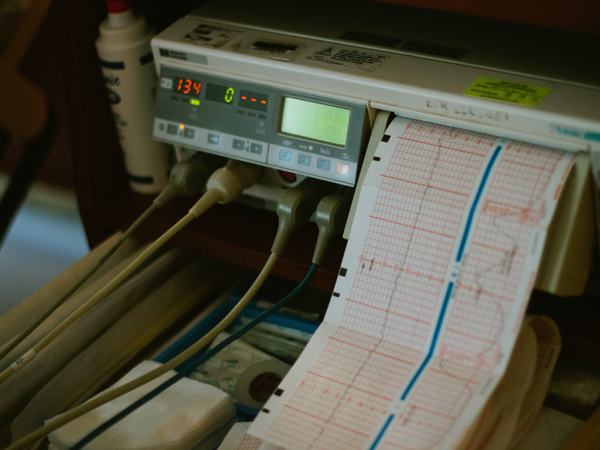5 Methods of induction of labor in hospital
When women go past their estimated due date (ET), they are often advised to induce. Induction may also be discussed earlier if there are complications in the pregnancy. Induction methods differ and there are some aspects that influence the choice of method.
Overall, artificial induction of labor should be viewed critically and questioned. In an artificial induction, the child does not determine the period of birth, so it does not show that it is ready for birth. Nevertheless, there are reasons why induction is necessary. It should be started promptly and a cesarean section should be avoided if possible. However, this article will not deal with the reasons for induction and the more detailed questioning of induction itself in more detail.
Rather, in this article I would like to introduce you to five common methods of induction of labor, most of which are used in hospitals. A distinction should be made between mechanical and chemical induction methods.
Summary
How to deal with the induction
For many women who exceed the ET, which, by the way, is only an average value as I describe in more detail in my article The thing with the birth date, sooner or later the topic of induction is raised. The important thing to remember, even when it comes to medical induction methods from the hospital, is that the vast majority of babies send out the signal for labor to begin. Only when it is really necessary should the start of labor be interfered with.
When the supply in the uterus becomes scarce, the hormonal situation changes and thus naturally initiates the birth. In very few cases this is not the case. Or there is another (emergency) siutation why the baby should be born and artificial induction becomes necessary.
Basically, there are very positive reports of experiences with all induction methods, but also downright horror stories. All methods have their advantages and disadvantages.
If you are unsure, you can use a german questioning technique to find out if this intervention is really necessary. This question system is called VRANNI and you can order it free of charge as a SafetyCard from Traum(a)Geburt e.V. and put it in your maternity passport. This decision aid contains the following questions:
- V: Vorteile (Advantages)? What are the advantages of the treatment?
- R: Risiken (Risks)? What are the risks of the treatment?
- A: Alternativen (Alternatives)? What are the alternatives?
- N: Notfall (Emergency)? Is it an emergency right now?
- N: Nichtstun (Do nothing)? What happens if nothing is done?
- I: Intention? What does my gut tell me?
Your doctor should take enough time to talk to you about your concerns, fears, but also wishes, and thus make a decision. You could also ask again specifically about the amount of amniotic fluid and the condition of the placenta.

If you notice that you yourself are very stressed about the beginning of the birth, it can help you to meditate and reflect on how you are feeling right now and what you need. In doing so, you may also be able to perceive fears and consciously dissolve them. If you can't cope with this on your own, you can always seek support for it!
Basically, meditation can be a way to relax and let go. Sometimes, with increasing relaxation, the birth eventually starts all by itself. Besides meditation, there are of course many other relaxation techniques. Here you best look in peace during pregnancy, what does you good and what helps you to relax.
You can then use these techniques during the birth and of course during the induction to let go of tension, to get involved in the birth and to focus.
It can also help to talk to others about your fears and worries. Writing down your own thoughts can also be a good help to let go of them so that they are no longer constantly circling around in your head.
If the effects of the induction are still waiting to be felt, thoughts often revolve around the upcoming birth as well. In this case, it can help if you consciously distract yourself and occupy yourself with something else. You could, for example, watch a movie, go for a walk, take a shower or whatever else does you good and is possible at the moment.
In addition, it makes sense to use positive, powerful phrases. This way you can go into the birth full of confidence in yourself, your body and your baby and experience the birth. For example, a possible such phrase would be, "Each wave brings me closer to my baby." or "I am full of confidence in myself and my body."
During strong contractions, as is sometimes the case during inductions of labor, conscious breathing can help. Rapid, shallow breaths make us panic easily and inhibit oxygen delivery to our baby. You can practice conscious breathing while you are still pregnant, and your birth companions can remind you if needed.

If the pain of labor overwhelms you and you can't get any further with breathing and relaxation techniques, you are of course also allowed to ask for help and thus, for example, a painkiller. Hospitals have different options here and it doesn't always have to be an epidural directly, although this can be an option as well.
Now that I have described a few aspects of how to deal with the topic of induction of labor, I will now talk specifically about the various induction methods that can be used in the hospital.
Mechanical methods of induction
There is a general distinction between natural, mechanical and chemical induction methods. I will describe the natural methods in more detail in another article. These are used rather less in the hospital.
The goal of mechanical induction is to stimulate the cervix of the pregnant woman herself to release increasing amounts of prostaglandins, thus starting the birth. I will discuss prostaglandins in more detail in the section on chemical induction of labor.
1. balloon catheter
A balloon catheter is a small tube with one or two balloons at its end. This tube with the balloons is first inserted into the woman's uterus through the cervix. One balloon should be placed at the inner cervix and the second balloon at the outer cervix.
Now the balloons are filled with a sterile liquid, which causes the cervix to dilate. The cervix is also stretched as a result. As it stretches, the body releases prostaglandins, which helps the cervix to mature and is thought to promote the production of the patient's own contractions.
Insertion of the balloon catheter, as well as stretching, is described by many women as painful, especially if the cervix was still closed. There may be some bleeding during this process. Otherwise, I could not find any other side effects. In practice, it is used relatively rarely.
The advantage of the balloon catheter is that the body does not receive any chemicals, i.e. no foreign hormones. This means that there is no hormonal imbalance, which is why this method of induction is sometimes described as a gentle method, although some women perceive this differently.
There is no guarantee when using this method of induction that it will have the desired effect. Because the catheter helps the cervix to mature relatively well, but it does not necessarily start labor, it is not uncommon for an oxytocic agent to be administered as well. I will describe this in more detail below.
After a previous cesarean section, this method should not be used, as I read in this summary of the S2k guideline published by the German Society for Gynecology and Obstetrics (DGGG). Basically, one should be very sensitive with induction attempts after a previous cesarean delivery.
2. opening of the amniotic sac
For the opening of the amniotic sac there is also the term amniotomy. Medically, it is called amniotomy. This relatively old method of inducing labor is used relatively rarely nowadays. Much more often, the amniotic sac is broken in the course of birth if the birth is not progressing fast enough. This definition of birth progress, by the way, is open to question.
There are different methods or tools with which the amniotic sac can be opened. In the past, it was mainly scratched with a fingernail. Today, a small hook or a glove with such a hook is more commonly used for this purpose. This allows the amniotic fluid to drain out. Otherwise, the amniotic sac usually opens in the course of the birth, sometimes the birth also begins with the bursting of the amniotic sac and labor starts in the optimal case in the following hours. This is also the goal of manual amniotic sac opening.
Now prostaglandins should also be released to start the birth. The method is controversial because the risk of infection increases significantly with the amniotic sac opened. Moreover, this is often not sufficient as the sole method of induction, so that additional chemical methods such as an oxytocic become necessary.
In addition, opening the amniotic sac increases the risk of umbilical cord prolapse, in which the child may no longer be adequately supplied. The aforementioned risk aspects explain why this method is currently used so rarely. In addition, there is no guaranteed effect and the method is perceived very differently and is sometimes described as painful. With regard to the perception of pain, it helps here, just as with the balloon catheter and eipolysis, if the cervix is already slightly open.
The only advantage here, as with all mechanical insertion variants, is that there is no influence on the hormone balance, since primarily no chemicals are used.
3. ovipositor detachment
During pregnancy, the amniotic sac is firmly attached to the uterus. In egg pole detachment, the outer amniotic sac is gently detached from the uterus near the cervix with a finger by gentle massage. There may be some light bleeding here as well. Egg pole detachment is thought to cause the body to release its own prostaglandins, thus beginning the birth process.
In about 50% of cases where this method is used, labor begins within 48 hours. Thus, there is no guarantee of its effectiveness. The effectiveness of ablation has been proven from the 38th week of pregnancy, however, it is often recommended to use it only from the 40th week of pregnancy. Towards the due date, the probability increases that your own body and also the baby are really ready for birth.
Egg release is usually performed only when the cervix is slightly open, otherwise this can be very painful. Overall, women describe this method very differently. Even with a slightly open cervix, ovipolysis can be very unpleasant.
However, the advantage here, just as with the other mechanical insertion methods, is that the body's own hormone balance is not upset. Further chemical methods of induction are often not necessary for egg release.
Chemical induction methods
During childbirth, there is a complex interaction of various hormones. In contrast to mechanical induction methods, all chemical induction methods directly interfere with the hormone balance. Hormones are specifically added to promote or intensify labor. Maturation of the cervix can also be supported chemically.
It has been statistically proven that chemical induction methods increase the likelihood of further interventions during labor. The probability of an epidural, for example, increases here. One of the reasons for this is that dosing with artificial hormones is very difficult and overdosing can easily occur. In addition, artificial and endogenous hormones differ.

Artificially supplied hormones are also usually supplied continuously and do not have the pulsating, surge-like release that endogenous hormones have during childbirth. As a result, some women feel overrun, feel significantly more pain (also because the body's own painkillers, the endorphins, are produced in significantly smaller quantities) and the breaks in labor can be significantly reduced or eliminated altogether. This means that a so-called labor storm, a continuous contraction, can occur.
If you had a birth by cesarean section before this birth, chemical induction is not recommended. Here, the stress on the scar can be very great in the event of a labor storm.
Chemical induction methods increase the likelihood that the baby will be born within 24 hours. However, as with all induction methods, there is no guarantee. Births induced with artificial hormones can also take a long time and result in a cesarean section.
With all chemical induction, a prolonged CTG must be written after administration to monitor the body's response to the dosage. This may limit movement, depending on the equipment in the clinic. In addition, vaginal examinations are performed more frequently with chemical initiations to detect changes in the cervix.
4. prostaglandins
Normally, prostaglandins are produced by the body in sufficient and appropriate amounts. Prostaglandins cause the cervix to be ripe and soft for delivery. Likewise, contractions are enhanced by prostaglandins, among other things.
Prostaglandins can be used in various forms of administration and medications in the induction of labor. Prostaglandin E1 with the active ingredient misoprostol and prostaglandin E2 with the active ingredient dinoprostone are used. Misoprostol is known by the trade name Cytotec.

If the findings during the examination are that the cervix is still immature but that the child must be born promptly, prostaglandins are usually given first. In this case, prostaglandin E2 is introduced vaginally as a gel or suppository. These can also be used to strengthen contractions.
If the cervix is already ripe, or if attempts at induction with gel or suppositories do not have the desired effect, tablets can be used. The medication taken orally is then prostaglandin E1, i.e. misoprostol. The dosage is much more difficult here. It is used off-label, which means it is not approved for this use. Cytotec is actually approved for the treatment of gastric mucosal damage. In obstetrics, however, much lower doses are needed of this condition.
At times it is necessary to take or introduce prostaglandins more than once because the effect is not always as rapid. The interval is usually six hours or more.
5. pitocin
Pitocin is artificial oxytocin. Oxytocin is also significant for the efficacy of contractions, which is why induction with Pitocin is intended to start or increase labor.
Pitocin is usually given via access and is most commonly known as the classic contraceptive drip. However, artificial oxytocin cannot be broken down by the body as well as its endogenous counterpart. In addition, there are the side effects that I already described at the beginning for all chemical induction methods, such as the possible labor storm and the lack of adaptation to the birth process.

Because the contraction drip is a forced contraction, artificial oxytocin is often needed again after birth to prevent or stop heavier bleeding.
Overall, Pitocin should be started at a slow, low dose to see how you and your baby are doing with it. Then the dose can be progressively increased as you go along. It is not uncommon for administration during labor to alternate between labor augmentation and labor inhibition when a storm of labor occurs without breaks.
Additional information
A possible induction of labor can be very stressful for pregnant women. Depending on what experiences you have heard from those around you and or even what experiences you may have had yourself with the issue, you may lean one way or the other and be accompanied by emotions accordingly.
Conclusion
Now I've given you some information about common induction methods in the hospital. I hope it became clear that each method has its own advantages and also disadvantages. In addition, it is important for me to emphasize once again that every woman feels differently about the respective methods.
This is, of course, related to the method itself, but also to various other factors, such as one's own attitude and experience with induction, as well as factors related to the environment. These include the interaction of the obstetric team, the atmosphere, the staffing ratio, the room design, and much more.
In this context, I addressed the issue of shame during childbirth in my article What I'm ashamed of during childbirth.
Overall, I perceive that it helps women a lot to learn about the different methods in advance. Ignorance often leads to tension and worry, whereas knowledge creates confidence and security, which is especially important during a birth.
I wrote this article as a doula to the best of my knowledge and research. The clarification and consultation in individual cases is always done by a doctor and/or midwife. I also make no claim to completeness.
What exactly a doula does and what advantages this form of birth support brings with it, I describe in more detail in my article The advantages of a doula.
No comments yet.